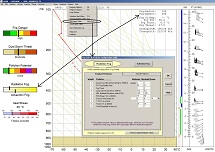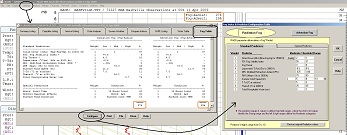Fog Index Table
Configuration Options
The Fog Index & Predictor Configuration Table provides an easy method to individually configure a sounding's key meteorological parameters and indices which help predict fog occurrence. RAOB uses this table's configuration settings to produce the Fog~Radiat & Fog~Advect parameters as fog predictors for Radiation and Advection fogs, respectively. These 2 parameters can be displayed on the Sounding diagram using the Custom Data Displays listing option, or they can be plotted on the Cross-Section, Time-Section, or Custom View meteograms.
This Table permits individual configuration options for Radiation and Advection fogs. Each fog predictor has 2 configuration options: a Weighting Factor and Probability Ranges, as seen below. See video.

Weighting Factors. Each predictor can be assigned a weight from zero to ten (0 - 10). The default value is one, but non-global predictors are initially set to zero, where a zero value eliminates the parameter from table summaries. Values greater than one add more relative weight to predictors that are more significant than others.
Probability Ranges. Fog probability ranges are defined with respect to 3 levels of significance: Low, Mid, and High. RAOB allows the user to define the lower & upper limits of the "Mid" probability range, thereby permitting automatic definition of the remaining "Low" and "High" probability ranges. The default values are typically valid for the eastern U.S. region, but all values should be modified to reflect local conditions.
The "Cloud Cover" predictor is unique because it only allows threshold values with respect to 4ths of cloud cover (0=clear, 1=few, 2=scattered, 3=broken, and 4=overcast), because these values are automatically determined from RAOB's internal cloud algorithms (unless manually entered via the Cloud Layer Table.
It is very important that the sequence of the Mid (left & right) probability values be correct. For example, increasing numbers indicate that the parameter potential increases with bigger values (like RH%), whereas decreasing numbers indicate that the parameter potential increases with smaller values (like T-Td). Note that the "Total Precipitable Water" (TPW) predictor uses opposite trends with respect to Radiation and Advection fogs, because larger TPW values favor advection fogs while smaller TPW values favor radiation fogs.
For parameters that have double-sided limits (such as the "Surface Wind Speed"), two additional probability values are needed to accurately define probability boundary values. In these cases, the first two and the last two values define the "mid" ranges, while the middle two values define the "high" range.
Standard Predictors .vs. Special Predictors. The Radiation and Advection fog types each contain a separate set of predictors that can be uniquely configured. For each fog type (radiation and advection), there are "Standard" and "Special" predictors as indicated by the table Tabs. The tab of "Special" predictors are initially set to a weight of zero, because they are most sensitive to local conditions and can not be easily configured to reflect global conditions. These "Special" predictors must be individually set by the user to not only reflect local conditions, but they should also be modified to reflect different sounding sites as needed.
Click image to view example of how the Fog~Advect and Fog~Radiat parameters can be displayed on the Sounding's custom data display and graphically with the Fire & Air-Quality diagram display.
Click image to see how Fog Table details can be viewed with the Listings option and how to configure Fog predictors at the same time.

